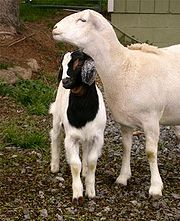Goats/Sheep
From Comparative Physiology of Vision
| " | Ungulates (Goats/Sheep) | |
|---|---|
 |
|
| Conservation status | |
|
Domesticated
|
|
| " | Scientific classification | |
| Kingdom: | Animalia |
| Phylum: | Chordata |
| Class: | Mammalia |
| Order: | Artiodactyla |
| Family: | Bovidae |
| Subfamily: | Caprinae |
Contents |
General Anatomy & Unique Visual Optics
The goat and sheep's eye is similar to a human eye, with a lens, cornea, iris and retina. A crucial difference though, is that the retina is shaped like a rectangle. This offers these ungulates massive peripheral vision, a panoramic field of 320-340 degrees! However, this trait tends to reduce the animal's ability to perceive depth as well as its binocular field to that of only 20-60 degrees. [1] [2] This is often a sacrifice made by prey animals who gain advantage by superior area vision. The large size of the retina also allows for rather good night vision, and a filament like Tapetum Lucidium, similar to the kind found in cows [3] contributes greatly to night vision. Interestingly Sheep and Goats are farsighted with a slight astigmatism[2], another common trait of prey animals.
Color Vision
Goats are Dichromats, they have two cone Opsin proteins, a Short Wavelength Sensitive Cone (SWS or S-cone) that has a maximum absorbance at 444-455 nm(bright purple). The second Opsin protein is Long Wavelength Sensitive Cones (LWS or L-cone) which has a maximum absorbance at 553nm (Yellowish-green)[1] Like other dichromats, they use the relative strength of the two signals to ascribe a 'color' to the signal. This can be mathematically plotted using the log of the absorbance at a particular wavelength. Colors that fall within Sheep Vision Range: Violet, Blue, Cyan, Green, Yellow, Orange and a slight bit of Red (red color is 620-750nm while sheep can see up to 650nm)[4] Despite the wavelength for red being visible to sheep, they are unable to interpret the color as Red, due to being dichromatic (Red-green colorblindness) This has implications to their interpretation of yellow and orange as well since yellow and orange are visualized by the combination of red and green receptive cones. We can hypothesize ungulates interpret the wavelengths for yellow, orange or red differently than we do due to lacking the L-Cones cones necessary to translate the designated wavelengths to “red.” Thus Sheep and Goats are certainly able to see purples, blues, and greens very well, but other colors (as we see them) are questionable. Depth is measured by the eye in a dichromat by the relative noise of a chromatic signal.[5]
Motion Detection
Ungulates, with their wide angle vision, are also especially sensitive to motion. Like most livestock and prey animals, sudden quick motion will often startle a goat or sheep. This suggests that motion detecting is highly valuable in evading potential predators, and to quickly escape being snuck up on. [6]
Higher Order Visual Perception
Due to their hyperopia (farsightedness) with astigmatism sheep likely perceive a well-focused image of objects in middle and long distance ranges. This is very helpful in a prey species. Sheep have the ability to recollect up to 50 unique human or sheep faces for as long as 2 years. This has implications for the importance of herd dynamics in grazing ungulates as well as the emotional attachment sheep may possibly form between herd members.[7]
Evolutionary Significance
The placement of the sheep and goat's eyes to the side of the head allow the ungulates to have a wide field of vision while sacrificing depth perception. [2] Also the rectangular pupil in the eyes of cows, sheep and goats, as well as other ungulates probably originated from a common ancestor. This feature is shared with some cephalopods, such as cuttlefish and octopus, which shows a remarkable evidence of convergent evolution. In terms of comparison with mammalian Opsin proteins, the ungulate's Opsin is only three amino acid substitutions different from the human's Opsin protein. [5]
Sources
- ↑ 1.0 1.1 Chuan-Chin Chiao, Misha Vorobyev, Thomas W. Cronin, Daniel Osorio, Spectral tuning of dichromats to natural scenes, Vision Research, Volume 40, Issue 23, January 2000, Pages 3257-3271, ISSN 0042-6989, 10.1016/S0042-6989(00)00156-5.(http://www.sciencedirect.com/science/article/pii/S0042698900001565)Keywords: Spectral tuning; Natural scene; Color vision; Dichromacy; Visual ecology
- ↑ 2.0 2.1 2.2 Judith K Blackshaw. Accessed 11/23/11; http://animalbehaviour.net/JudithKBlackshaw/JKBlackshawCh3d.pdf
- ↑ Ollivier, F. J., Samuelson, D. A., Brooks, D. E., Lewis, P. A., Kallberg, M. E. and Komáromy, A. M. (2004), Comparative morphology of the tapetum lucidum (among selected species). Veterinary Ophthalmology, 7: 11–22. doi: 10.1111/j.1463-5224.2004.00318.x
- ↑ http://www.neitzvision.com/content/publications/1998-jacobs-dichromacy_cows_goats_sheep-visneuro.pdf
- ↑ 5.0 5.1 F.Bernhard Radlwimmer, Shozo Yokoyama, Cloning and expression of the red visual pigment gene of goat (Capra hircus), Gene, Volume 198, Issues 1-2, 1 October 1997, Pages 211-215, ISSN 0378-1119, 10.1016/S0378-1119(97)00316-8. (http://www.sciencedirect.com/science/article/pii/S0378111997003168) Keywords: Opsin; Wavelength absorption; Color vision; Vertebrate
- ↑ Musgrave, S.D., and G.W. Thrasher, eds. "Behavioral Principles of Livestock Handling." Behavioral Principles of Livestock Handling (With 1999, 2002, and 2010 Updates on Vision, Hearing, and Handling Methods in Cattle and Pigs). American Registry of Professional Animal Scientists , 2002. Web. 28 Nov 2011. <http://www.grandin.com/references/new.corral.html>.
- ↑ http://0-search.ebscohost.com.cals.evergreen.edu/login.aspx?direct=true&db=a9h&AN=5591969&site=ehost-live
http://192.211.16.33/illiad/ever/pdf/269669.pdf
